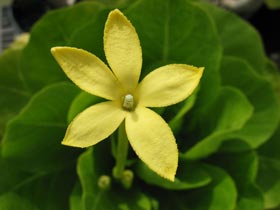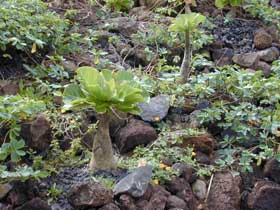Brighamia insignis
Genus
Brighamia
Species
insignis
Hawaiian Names with Diacritics
- Hāhā
- Pū aupaka
- Ālula
- ʻŌlulu
Hawaiian Names
- Alula
- Haha
- Olulu
- Pu aupaka
Common Names
- Cabbage-On-a-Baseball-Bat
- Cabbage-On-a-Stick
- Hawaiian Palm
Synonyms
- Brighamia citrina
Distribution Status
Endemic
Endangered Species Status
Federally Listed
Plant Form / Growth Habit
- Shrub
Mature Size, Height (in feet)
- Shrub, Small, 2 to 6
- Shrub, Medium, 6 to 10
- Shrub, Tall, Greater than 10
Mature Size, Width
Uncommon to be wider than 3 feet or so even with branching. [Michael DeMotta, National Tropical Botanical Garden]
Life Span
Long lived (Greater than 5 years)
Landscape Uses
- Container
- Specimen Plant
Additional Landscape Use Information
Ālula are rather easy to cultivate in pots but do require dry conditions in a partly sunny location. They can be given frequent watering in pots but use a well-aerated soil mix (i.e. for succulents and cactus) that allows for immediate or perfect drainage. Black cinder is an excellent component to add to the soil mix whether in pots or outplanting in the ground.
If grown in the ground, provide very good drainage in partly sun areas and protect from slugs and snails.
Source of Fragrance
- Flowers
Additional Fragrance Information
Ālula flowers have a wonderful sweet fragrance described as honeysuckle- or citrus-like!
Plant Produces Flowers
Yes
Flower Type
Showy
Flower Colors
- Yellow
Additional Flower Color Information
The yellow tubular flowers are arranged in groups of three to eight. [1]
Blooming Period
- Sporadic
- September
- October
Additional Blooming Period and Fruiting Information
In the wild, they bloom in September and October. Flowers can be induced any time of the year in cultivation and sometimes blooms from 2 to 4 times a year. Even with irrigation, it seems that the amount of rain and cloudiness may affect their flowering cycles. [Michael DeMotta, National Tropical Botanical Garden]
Plant texture
- Coarse
Additional Plant Texture Information
The semi-succulent leaves are only at the top of the plant forming a rosette and range between 5 to 8 inches long.
Leaf Colors
- Light Green
- Medium Green
Additional Leaf Color Information
Bright lime green to dark green.
Additional Pest & Disease Information
The introduced carmine spider mites (Tetranychus cinnabarinus) can infest plants in a short while and has been observed to cause leaf loss in both wild and cultivated plants. [4] Leafminers can be an occasional problem.
Slugs and snails can be serious pests especially if plants are in the ground. African snails, especially, will devour all the leaves and the tips of all the stems in no time, killing the plant. [Michael DeMotta, National Tropical Botanical Garden]
Fertilizer
Ālula respond well to regular applications of foliar fertilizer or applications of slow release fertilizer twice a year. Using a high phosphorus fertilizer will induce blooming. Apply 3 months before. These palnts like nitrogen. So apply Miracle Gro (half strength) and foliar feed once a month. Osmocote Plus is used and replenished as needed. [Michael DeMotta, National Tropical Botanical Garden]
Pruning Information
Remove lower yellow and brown leaves for a cleaner appearance.
Water Requirements
- Dry
Additional Water Information
In pots, allow plants to dry slightly before watering. Overwatering can easily rot and kill the plant or cause fungal infection. The thick succulent stem allow plants to store water and survive periods of drought. Leaves diminish in size with water stored in plant decreases. [2] Ālula can take daily watering as long as they are able to dry out. Good drainage and soil aeration are essential. [Michael DeMotta, National Tropical Botanical Garden]
Soil must be well drained
Yes
Light Conditions
- Full sun
- Partial sun
Additional Lighting Information
Ālula does okay in full sun, but some full sun with some part shade seems to work best. [Michael DeMotta, National Tropical Botanical Garden]
Spacing Information
Usually in containers. If planted in ground about 2 to 3 feet apart.
Tolerances
- Drought
- Wind
- Salt Spray
Soils
- Cinder
Limitations
Ālula can be challenging to maintain in the ground because of snail/slug damage or poor drainage. Best if kept in pots. These succulents will rot if there is not sufficient drainage.
Having lost its natural pollinators in the wild, hand pollination is required for fruit development.
Natural Range
- Niʻihau
- Kauaʻi
Natural Zones (Elevation in feet, Rainfall in inches)
- 150 to 1000, 50 to 100 (Mesic)
- 1000 to 1999, 50 to 100 (Mesic)
Habitat
- Terrestrial
Additional Habitat Information
Once found mostly on windswept sea cliffs of Kauaʻi (Nā Pali Coast, Hāʻupu Ridge, Nāwiliwili) and most likely extinct on Niʻihau (Kaʻali Cliff).
Ālula experienced a serious set back in 1992 when Hurricane ʻIniki destroyed half the natural population (60 to 70 plants) along the Nā Pali Coast on Kauaʻi. The combined hurricanes of ʻIwa (1982) and ʻIniki destroyed 10 of the remaining 12 individuals in the Hāʻupu area. [1]
Locations where the last populations are known to exist on the Nā Pali coast were searched. Only one ālula is known to remain in the wild. [Ken Wood, National Tropical Botanical Gardens]
![]() Special Features and Information
Special Features and Information
General Information
The two species belong to the endemic genus Brighamia in the Campanulaceae or Bellflower family with some 2,000 species in 70 genera. This family is well represented in the Hawaiian Islands with some 130 species--all endemic!
Other native Hawaiian genera Clermontia, Cyanea, Delissea, Lobelia and Trematolobelia--all endemic genera except Lobelia.
Etymology
The endemic genus Brighamia, is named for William Tufts Brigham (1841-1926), geologist, botanist and the first direction of the Bernice P. Bishop Museum, Honolulu, Hawaiʻi.
The Latin specific epithet, insignia, meaning outstanding or distinguished in reference the plants unique appearance. [1]
Background Information
The two species are similar in some respects. Ālula (Brighamia insignis) has yellow flowers; Pua ʻala (Brighamia rockii) from Molokaʻi has white flowers.
While both species can grow to an amazing height of 16 feet, Brighamia insignis tends to be a larger plant than B. rockii. [1,3] Ālula and pua ʻala are perfectly designed for their windy habitats on steep coastal cliffs. The roots penetrate into rocky crevices and the swollen base of the plants allows them to rock in the strong wind. [2] Both species of Brighamia have lost their natural pollinators and now need hand pollination for fruit and seed production.
They may have been bird pollinated. [7]
The "Hawaiian Palm," as Ālula is known as in The Netherlands (Holland), England and other countries, is a popular house plant. Interestingly, because of the longer spring/summer hours in northern Europe, too much sunlight appears to cause leaf drop. The leaves soon appear as shorter days resume.
Early Hawaiian Use
Lei:
One older source (Charles Gaudichaud,1819) states that Hawaiians "used all fragrant plants, all flowers and even colored fruits" for lei making. Red or yellow were indicative of divine and chiefly rank; purple flowers and fruit, or with fragrance, were associated with divinity. Because of their long-standing place in oral tradition, the fragrant yellow flowers ālula were likely used for lei making by early Hawaiians, even though there are no written sources. [5]
Medicinal:
Botanist Otto Degener notes: "Brighamia, called by various natives puaala, alula, ohaha, was eaten raw as a supposed remedy for consumption and various other diseases." [6]
Additional References
[1] "Recovery Plan for Kauaʻi Plant Cluster," pages 24, 26.
[2] "Hawaiʻi's Vanishing Flora" by Bert Y. Kimura & Kenneth M. Nagata, page 58.
[3] "Recovery Plan for Molokaʻi Plant Cluster," page 30.
[4] Hawaii's CWCS Fact Sheets http://www.state.hi.us/dlnr/dofaw/cwcs/Conservation_need.htm [Accessed on 12/23/09]
[5] "Nā Lei Makamae--The Treasured Lei" by Marie A. McDonald & Paul R. Weissich, pages XIV-XV, 124.
[6] "Plants of Hawaii National Parks" by Otto Degener, pages 288, 290.
[7] "The Hawaiian Honeycreeper: Drapandidae" by H. Douglas Pratt, page 18.
PHOTOS FOR THIS SPECIES CAN BE SEEN AT THE LINK (Copy & Paste to your browser):
https://www.flickr.com/search/?user_id=50823119%40N08&sort=date-taken-desc&view_all=1&text=Brighamia%20insignis
Plant Gallery
Back to Plant List
Other Nursery Profiles for Brighamia insignis



